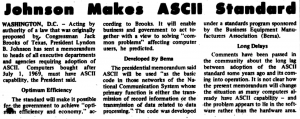March 27, 1968: ASCII character encoding adopted as federal standard under President Johnson
To improve efficiency within the federal government, President Lyndon B. Johnson issued a Presidential Memorandum requiring the adoption of ASCII character encodings.
Before these words could appear on your screen, your computer had to translate a series of zeros and ones into alphanumeric characters. To do these translations, computers rely on “character encodings” which define a standard mapping between binary data and alphanumeric characters. Although several different character encodings emerged over the course of history, only two – ASCII and UTF-8 – are widely used today.

ASCII, an abbreviation for the American Standard Code for Information Interchange, was first used in the 1960s as telegraph code. These origins are reflected in the ASCII character set, which uses 7-bit integers to represent 95 printable characters (including numerals, capital and small letters, and punctuation) as well as 33 telegraphy control codes. With just 128 characters, ASCII is limited to representing languages written in the Roman alphabet. A newer encoding called UTF-8, which includes over 140,000 characters representing nearly all modern languages, has overtaken ASCII as the most commonly used encoding on the internet. UTF-8 represents characters using one to four 8-bit bytes, making it capable of supporting over 2 million possible characters.
Today, ASCII and UTF-8 can comfortably coexist, since UTF-8 was designed to be backwards-compatible with ASCII. However, rival character encodings were responsible for massive data incompatibility issues back in the 1960s. Competing companies implemented different character encodings, resulting in situations where data from one device was unrecognizable to another. To minimize these incompatibility issues, President Lyndon B. Johnson issued a presidential memorandum adopting ASCII as a federal standard. The memorandum, a type of directive carrying the force of law, required that all federal computing equipment have ASCII compatibility and that ASCII be used for federal data processing.
The memorandum did not eliminate rival encodings from the computing industry. IBM, the largest and most powerful computer company of the time, continued to exclusively produce computers that used their own character encoding, called EBCDIC, until 1981.
–By Kathleen Esfahany